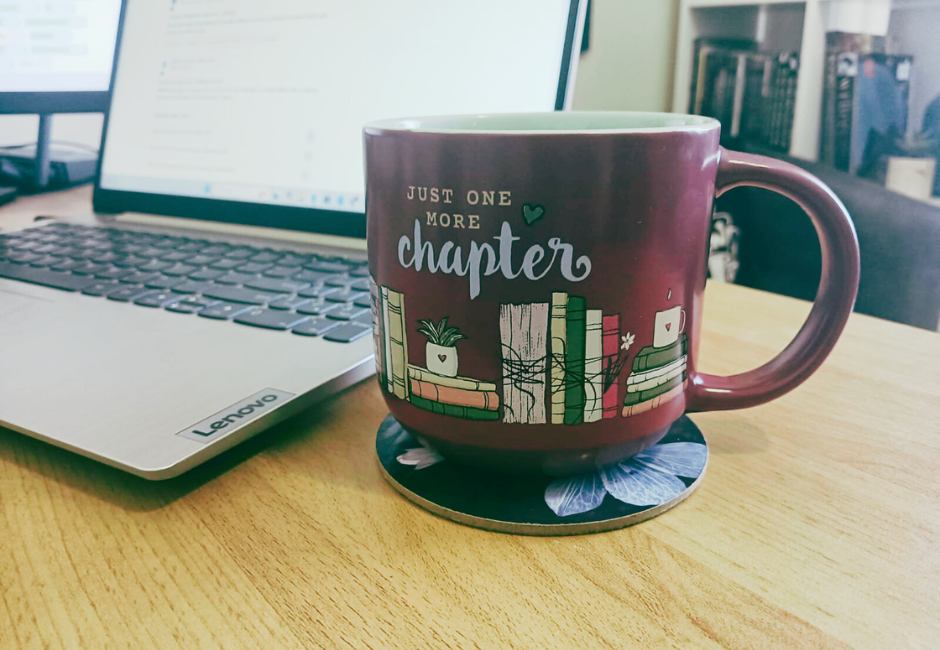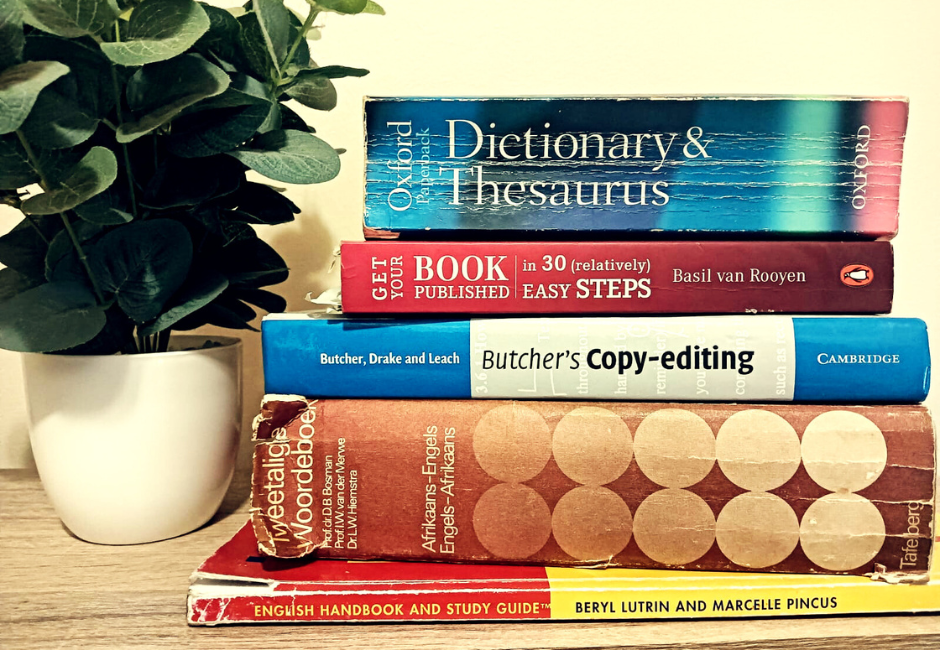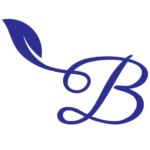What Does an Editor Do? A Day in the Life of BLE

Ever wondered what an editor actually does all day? Do we just sit in dimly lit rooms, red pen in hand, furrowing our brows at misplaced commas? Well, yes, sometimes. But editing is so much more than that. Managing client relationships, battling wayward spelling…editors juggle a lot behind the scenes.
So, take a seat as we simulate a day in the life of Blue Leaf Editing.
Table of Contents
Morning Routine: Caffeine, Emails & Planning
Step One: Wake Up and Fuel Up
► Cups of coffee consumed so far: 1 (but it won’t be the last)
Every great editorial day starts with caffeine. Whether it’s a strong coffee or a good old-fashioned cup of tea, editors need something to keep them going.
We’re morning people. It’s just not in us to start the day late. So, we get up at 07h00, put the kettle on, and enjoy the solitude for about half an hour before switching to work mode.

Step Two: The Email Avalanche
► Emails checked: 12
► Quotes sent: 2
► Spelling errors spotted in emails: 3 (none of them ours, obviously)
Mornings start with a hefty dose of emails. An editor’s inbox is a mixed bag – client queries, project updates, spam, and the occasional panicked email about a looming deadline. We check in with existing clients, respond to inquiries, and (let’s be honest) procrastinate slightly by scrolling through social media.
Emails also mean quotes and invoices. Every freelance editor knows the struggle of balancing administrative work with actual editing. It’s the reality of the business side of editing. You want to edit all the time because that brings in the money (and you love it). But if you don’t do the admin (unpaid) work, it might harm the paid work.
So, we dutifully send quotes for new projects, chase up payments, and update our records.
Mid-Morning: Editing Begins
► Words edited: 800
► Dictionary consultations so far: 2 (seriously, ‘judgment’ or ‘judgement’?)
With admin out of the way, it’s time to get stuck into editing. At the moment, we’re working on manuscripts (mostly academic) and blogs. As we said, we’re at our best in the morning, so we usually tackle the nuances of academic editing first.
Types of Editing We Might Be Doing
The type of edit depends on the quality of the manuscript and, of course, the publisher’s brief. So, it can be any one or a mixture of these:
- Copy Editing – We check for errors in grammar, punctuation, and spelling.
- Substantive or Line Editing – We improve structure, clarity, and flow on a sentence and paragraph level.
- Proofreading – The final polish before publishing.
Editors must have a sharp eye for detail. But even our eyesight gets foggy sometimes. That’s where editing tools and software come in handy. For manuscripts, we like using Grammarly and good ol’ MS Word spell check.
Yes, we know they’re not always reliable, but they’re good for the nitty-gritty stuff: double spaces, missing full stops, typos. Especially when track changes is on. All the reddreadsometimes disguise a new mistake you accidentally introduced.
And of course, an editor’s day wouldn’t be complete without the occasional head-scratcher. Did you know there are multiple correct spellings of ‘focused’? You do now.
Lunch Break: Stepping Away from the Screen (Or Not)
► Cups of coffee consumed: 3
► Number of work-related articles skim-read: 4
Lunch breaks are an excellent opportunity to step away from the screen…or, in reality, catch up on publishing news, research trends, and maybe even read for pleasure (editors do this, too).
Freelancers often struggle with switching off, so even during lunch, there’s often something editor-related going on in the background.
But on the really good (or bad) days, we try to step away completely, make a hearty lunch, and watch a sitcom. Watching made-up characters deal with silly problems helps our brains to reset. The Golden Girls is our current binge.
Afternoon: More Editing, Social Media & Admin
► Words edited: 2,500 (and counting)
► Social media posts drafted: 2
► Grammar debates had with self: 1
The afternoon is for getting back into editing mode. Deadlines loom, publishers expect quality work, and freelancers must balance speed with accuracy.
We prefer working on shorter pieces of content in the afternoon. Therefore, blogs are on the menu most days, whether it’s for a client or our Turning a New Leaf blog. Editing blogs differs from editing manuscripts, so we feel it stretches another set of creative muscles.
Tweaking headings and producing irresistible calls to action keeps our wordplay on its toes. Plus, we sometimes get to give input on design elements. Thinking visually is also a type of editing. After all, knowing when an infographic or table will be more useful to a reader than text contributes to the blog’s overall readability.
Social Media: It’s Work, We Promise!
Yes, social media is part of the job. Making designs on Canva is fun (and often camouflage for procrastination). But promoting services, engaging with fellow freelancers, and sharing editing tips are essential for running an editorial business. A well-maintained presence on platforms like LinkedIn can bring in new clients and keep us connected with the publishing world.
While a tired adage, “it’s about who you know” still rings true. Two of our biggest clients came to us through networking. The freelancing world is big, and the scary reality for most of us is that our voices get lost in the void. Simply creating a website and LinkedIn profile, and expecting clients to find you, isn’t enough. It’s about reaching out and squarely putting yourself in view.
So, we fake-it-till-we-make-it on social media and encourage other freelance editors along the way.
The Research Never Stops
Editors work across multiple industries, so fact-checking is a must. The list of things we’ve fact-checked just this week includes:
- UK vs US spellings and usages
- Statistics and dates
- Laws (mostly SA and UK)
- Terminology of different academic fields
- Product specs
- Capitalisation rules
Then more obscurely:
- Whether torque tools have Bluetooth capabilities
- Which mobile apps spouses use to cheat in relationships
- Various Regency-specific terms (honestly, what is a curricle?)
The research never really stops. Our reference books have cracked spines and well-thumbed pages that testify to that.

Wrapping Up: Final Checks & Planning for Tomorrow
► Total words edited: 4,000+
► Emails sent: Too many to count
► Cups of coffee consumed: 5 (because editing is thirsty work)
As the day winds down, we like to plan for the next day. We still prefer a physical diary with a written to-do list we can satisfyingly cross out. Freelance editors must juggle multiple projects, so staying organised is key. Thinking “I’ll remember that” is likely the biggest lie in history.
A final check of emails and social media, then we shut down. We’re not big fans of working late nights, while other editors are at their most productive at night. That’s the point: working according to a schedule that suits you best.
Our evening wraps up with a stroll in the park, indulging our MasterChef obsession, reading, and spending quality time with loved ones.
So, What Does an Editor Do?
A little bit of everything. Editing isn’t just about fixing grammar and punctuation. It’s about the 4 Cs: clarity, coherence, consistency, and communication. Whether working for a publishing house, a freelance client, or a company’s editorial team, editors ensure that words make sense. We oversee readability, make suggestions, and (sometimes) have the final say in how a manuscript reads.
It’s a mix of skill, patience, and a touch of pedantry – and honestly, we wouldn’t have it any other way.

Blue Leaf Team
The Blue Leaf Editing team has over 15 years of combined editing, publishing, and book industry experience. We’re passionate about content and storytelling, and sharing our knowledge with others.
info@blueleafediting.com